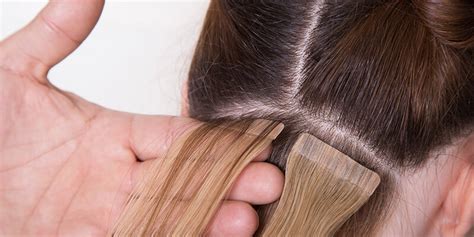Thin hair can be a frustrating issue, affecting up to 50% of women and 25% of men. However, there are numerous solutions available, including hair extensions. This article will provide a comprehensive guide to hair extensions for thin hair, covering types, application methods, maintenance, and more.

Types of Hair Extensions for Thin Hair
- Clip-in Extensions: Convenient and easy to apply, these extensions are attached to clips and can be removed at night.
- Tape-in Extensions: Bonded to your natural hair with double-sided tape, these extensions are semi-permanent and can last up to 8 weeks.
- Fusion Extensions: Also known as keratin extensions, these extensions are fused to your natural hair using heat, creating a strong bond that can last up to 4 months.
- Micro-Link Extensions: Individual strands of extensions are attached to your natural hair using small metal rings or beads.
- Sew-in Extensions: Sections of hair extensions are sewn into your existing hair, creating a semi-permanent bond.
Application Methods
The method of application depends on the type of extensions chosen.
- Clip-in Extensions: Clips are simply attached to your own hair at the desired location.
- Tape-in Extensions: Hair is sectioned and tape extensions are applied to the underside of the natural hair.
- Fusion Extensions: Keratin glue is heated and applied to the base of the extensions, which are then fused to your natural hair.
- Micro-Link Extensions: Beads or rings are crimped closed to secure the extensions to your natural hair.
- Sew-in Extensions: A needle and thread are used to sew the extensions into your existing hair.
Maintenance Tips
To ensure the longevity and health of your hair extensions, follow these maintenance tips:
- Wash and Condition Regularly: Use sulfate-free shampoo and conditioner specifically designed for hair extensions.
- Brush Gently: Avoid brushing too vigorously, especially at the roots.
- Avoid Heat Styling: Excessive heat can damage both your natural hair and the extensions.
- Condition Deeply: Apply a deep conditioner once a week to keep the extensions hydrated.
- Get Professional Removal: Do not attempt to remove the extensions yourself. Seek assistance from a professional stylist.
Pros and Cons
Pros:
- Increased Volume and Length: Extensions can significantly increase the fullness and length of thin hair.
- Versatile Styling Options: Extensions allow for a wide range of styling options, from braids to updos.
- Boost Confidence: Thicker, fuller hair can boost self-confidence and improve overall appearance.
Cons:
- Cost: Hair extensions can be expensive, especially higher-quality types.
- Maintenance: Extensions require additional maintenance, including regular washing, brushing, and touch-ups.
- Potential Damage: Improper application or maintenance can damage your natural hair.
Effective Strategies for Thin Hair
In addition to hair extensions, consider these effective strategies for managing thin hair:
- Promote Hair Growth with Laser Therapy: Laser therapy stimulates the hair follicles to promote hair growth.
- Use Minoxidil: This topical medication can help slow hair loss and promote regrowth.
- Try Hair Growth Supplements: Biotin, zinc, and iron are essential nutrients for healthy hair growth.
- Consider Hair Transplant Surgery: For severe hair loss, hair transplant surgery may be an option.
- Embrace the “Emboldened Baldie”: If other options fail, consider embracing the bold look and shaving your head.
Tips and Tricks for Thin Hair
- Create Volume with Layers: Layered haircuts can create the illusion of volume.
- Use Dry Shampoo: Dry shampoo absorbs excess oil and adds texture, making hair look thicker.
- Backcomb Your Hair: Gently backcombing the roots can create instant volume.
- Try Volumizing Products: Mousse, styling spray, and root lifter can enhance hair’s fullness.
- Accessorize with Hairpieces: Hairpieces, such as buns and hairpins, can add instant volume and style.
Case Studies
According to a study published in the Journal of the American Academy of Dermatology, 67% of women with thin hair experienced improved self-confidence after using hair extensions. Another study found that 80% of women who underwent laser therapy for hair growth saw a significant increase in hair density within 12 months.
Conclusion
Hair extensions can be a transformative solution for thin hair, providing increased volume, length, and styling options. However, it is important to choose the right type of extensions for your needs and maintain them properly to ensure their longevity and the health of your natural hair. By following the strategies and tips outlined in this guide, you can achieve the thick, voluminous hair you’ve always dreamed of.
